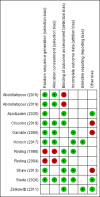Early psychological interventions for prevention and treatment of post-traumatic stress disorder (PTSD) and post-traumatic stress symptoms in post-partum women: A systematic review and meta-analysis
- PMID: 34818326
- PMCID: PMC8612536
- DOI: 10.1371/journal.pone.0258170
Early psychological interventions for prevention and treatment of post-traumatic stress disorder (PTSD) and post-traumatic stress symptoms in post-partum women: A systematic review and meta-analysis
Abstract
Background: Pre-term or full-term childbirth can be experienced as physically or psychologically traumatic. Cumulative and trans-generational effects of traumatic stress on both psychological and physical health indicate the ethical requirement to investigate appropriate preventative treatment for stress symptoms in women following a routine traumatic experience such as childbirth.
Objective: The objective of this review was to investigate the effectiveness of early psychological interventions in reducing or preventing post-traumatic stress symptoms and post-traumatic stress disorder in post-partum women within twelve weeks of a traumatic birth.
Methods: Randomised controlled trials and pilot studies of psychological interventions preventing or reducing post-traumatic stress symptoms or PTSD, that included women who had experienced a traumatic birth, were identified in a search of Cochrane Central Register of Randomised Controlled Trials, MEDLINE, Embase, Psychinfo, PILOTS, CINAHL and Proquest Dissertations databases. One author performed database searches, verified results with a subject librarian, extracted study details and data. Five authors appraised extracted data and agreed upon risk of bias. Analysis was completed with Rev Man 5 software and quality of findings were rated according to Grading of Recommendation, Assessment, Development, and Evaluation.
Results: Eleven studies were identified that evaluated the effectiveness of a range of early psychological interventions. There was firm evidence to suggest that midwifery or clinician led early psychological interventions administered within 72 hours following traumatic childbirth are more effective than usual care in reducing traumatic stress symptoms in women at 4-6 weeks. Further studies of high methodological quality that include longer follow up of 6-12 months are required in order to substantiate the evidence of the effectiveness of specific face to face and online early psychological intervention modalities in preventing the effects of stress symptoms and PTSD in women following a traumatic birth before introduction to routine care and practice.
Prospero registration: CRD42020202576, https://www.crd.york.ac.uk/prospero/display_record.php?RecordID=202576.
Conflict of interest statement
I have read the journal’s policy and the authors of this manuscript have the following competing interests: PWM is clinical lead for Mirabilis health a private trauma-focused mental health service, which provides pro bono psychotherapy to participants for research projects. PWM provides EMDR training as a part of Mirabilis Health Academy. PWM is a member by invitation of the Council of Scholars; part of the Future of EMDR Therapy Project. The Project works on developing global EMDR standards for training and competency benchmarking guidelines in EMDR therapy. ES is the developer of the EMDR G-TEP protocol and provides training workshops for EMDR clinicians and is also a member of the Council of Scholars.
Figures
References
-
- Hernández-Martínez A, Rodríguez-Almagro J, Molina-Alarcón M, Infante-Torres N, Rubio-Álvarez A, Martínez-Galiano JM. Perinatal factors related to post-traumatic stress disorder symptoms 1–5 years following birth. Women and Birth. 2020. Mar 1;33(2):e129–35. doi: 10.1016/j.wombi.2019.03.008 - DOI - PubMed
-
- Garthus-Niegel S, Horsch A, Handtke E, von Soest T, Ayers S, Weidner K, et al.. The impact of postpartum posttraumatic stress and depression symptoms on couples’ relationship satisfaction: a population-based prospective study. Frontiers in psychology. 2018. Sep 19;9:1728. doi: 10.3389/fpsyg.2018.01728 - DOI - PMC - PubMed
Publication types
MeSH terms
LinkOut - more resources
Full Text Sources
Medical






